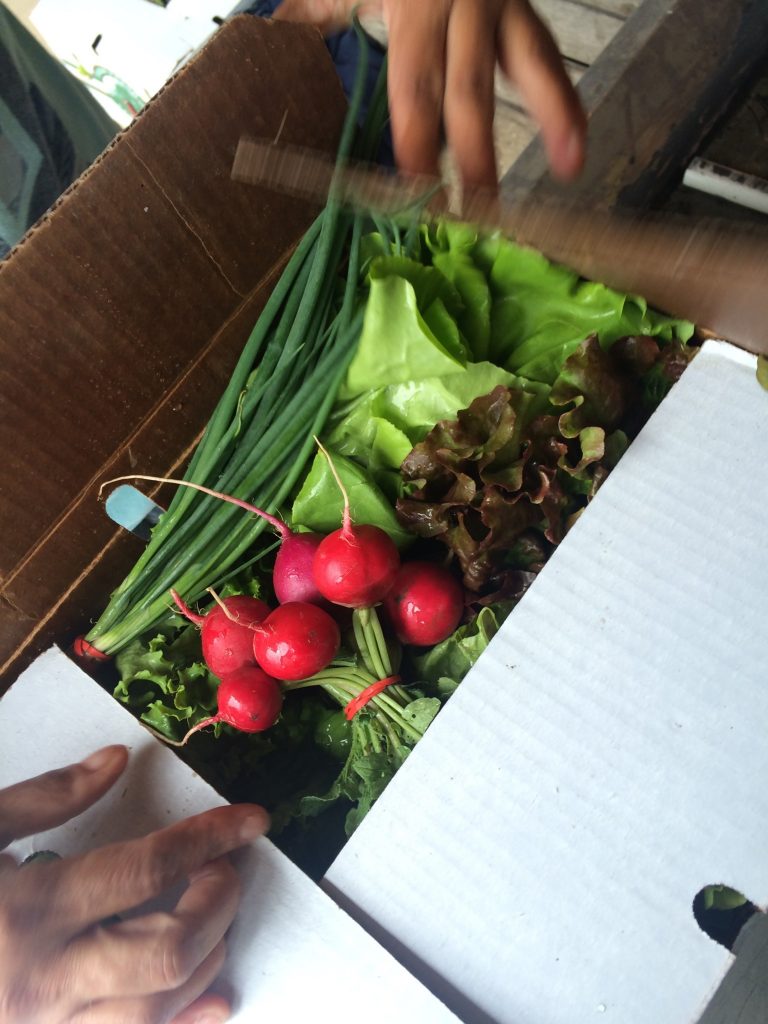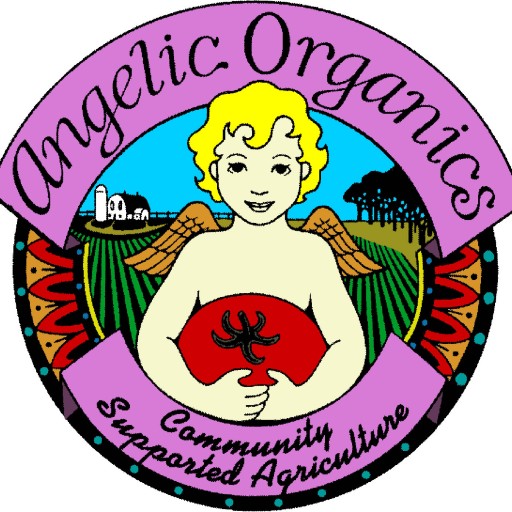Farmer John Writes: Unpacking the Mystery of the Pack
Harvest Week 15, September 14th – 17th
Your Box This Week – Saturday, September 17th
Please note: this summary is written before we pack your box—be aware that some guesswork is involved. At times, a bit of improvisation is required for selecting the contents of your share. As always, be sure to thoroughly wash all of your vegetables.
- Acorn Squash
- Pie Pumpkin
- Carrots
- Radishes
- Celeriac
- Broccoli
- Bunched Swiss Chard
- Lettuce (maybe)
- Joi Choi
- Jalapeño Peppers and Paper Lantern Peppers (in bag, hot)
- Sweet Pepper
- Flat Leaf Parsley
How to Easily Unfold Your CSA Box
The farm re-uses the vegetable boxes. Flaps are easily torn when the boxes are dismantled improperly. Please watch this short demonstration on how to correctly unfold your box.
Sign up for the Free Recipe Service
Make sure you sign up for the Local Thyme recipe service we offer with your share. It received many great reviews from our shareholders last season. Local Thyme has storage and handling tips, a vegetable identification guide, and recipes featuring 5 ingredients that are available in your box each week. Find the instructions for signing up for Local Thyme at www.angelicorganics.com/local-thyme.

Tumbling Carrots
Every Other Week
I assume that the readership of Farm News for our 10-week shareholders goes down during the week they don’t receive a share, since they don’t receive a hard copy newsletter that week, nor do they receive an email reminder that includes a link to Farm News that week. Therefore, if you are a 10 week shareholder, I encourage you to read the previous week’s newsletter. This will help you to experience the farm as more of a continuum. Years ago, before the Internet became prevalent, we sometimes published 4 page newsletters, so that I could share an extra long story. Today, we sometimes include extra text and photos in the online Farm News beyond what appears in the hard copy.
Extend Your Share up until Thanksgiving
When Thanksgiving rolls around, we want to make sure you can be celebrating with the organic bounty from your very own farm. Until we sell out, Extended Season Vegetable Shares are available at www.angelicorganics.com/extended-season
Pick a Pumpkin and Gourds at our Upcoming Field Day, Saturday, September 17
Kids love picking pumpkins and gourds on our Fall Field Day, Saturday, September 17. Mark your calendar. Please come around 11 a.m., so everyone can get their pumpkin and gourds before the potluck at 12:30 p.m. Learn more at www.angelicorganics.com/field-days-for-shareholders. Special features of this fall’s field day—a visit to the Learning Center’s new overnight educational facility and family pizza night–are posted in last week’s newsletter.
Farm Developments in 2016
In the previous two issues of Farm News, I wrote about developments at Angelic Organics this year that have combined to make for a better season overall: Our Secret Growing Manager and how The Farm Whispers. This week, I will Unpack The Mystery of the Pack.
Unpacking The Mystery of the Pack
For years (and years), I trained someone to run the pack. I did not personally run it; I felt I did not have the time to run it. I felt that it was a transferable task. I was wrong. It is as complex and challenging a responsibility as being the growing manager.
Your CSA box is 3/4 of a bushel. We convert the volume of all the crops we harvest into 20 bushel units, since the main measures/units of volume we harvest into are 20 bushel bins. We also harvest into crates of various dimensions, and then we convert that volume into units of 20 bushels. You might think that there would be the equivalent of 27 three-quarter bushel CSA boxes in a 20 bushel bin (27 boxes x 3/4 bu = 20.25 bushels or about one 20 bushel bin). However, this depends. For instance, 100 large bunches of kale fit into a 20 bushel bin, but the weight of the kale on top, along with the weight of the ice we add, will compress the volume of the kale to perhaps 9/10 of a bin, if the kale sits in the bin for one day. If the kale sits in the bin for 2 days, it might reduce the volume of the kale by perhaps 25%, because there is more settling and compression of the kale bunches on the 2nd day. So, the volume of the kale is a moving target. Additionally, depending on how wet the kale is when we pack it and how much moisture subsequently dissipates, it will spring forth and generate more volume than when it was sitting in its bin.
(About the bushel itself–I would normally provide you with a link to the bushel, a cornerstone unit of our agricultural heritage. However, having read The Secrets of the Great Pyramid and having marveled at its evidence regarding the origins of the ancient Egyptian standards of measurement, which have very possibly morphed into our current standards of measurement, I will not link you to the probable myths/disinformation regarding the origin of the bushel that are widely shared on Google.)

Radishes in our standard unit of volume, the 20 bushel bin
If we bag the equivalent of a bin of tomatoes (20 bushels), the bags of tomatoes might then create a volume of 23 bushels. We store the head lettuce in shallow 10 bushel bins, since it compresses too much in the deeper 20 bushel bins. Like kale, frilly lettuce sometimes springs forth when placed into the CSA box, taking up more room than anticipated.
And, of course, squash, cabbage, broccoli and other crops vary in size from one to the next. For instance, this past week, when we were sometimes putting in both a spaghetti squash and a red kuri squash, I instructed the packer putting in the red kuri to offset the size, depending on the size of the spaghetti squash. “If you see a large spaghetti squash going into the box, put in a small red kuri.”
Even when all of this is considered, each pack creates its own volume reality. The edges and curves of the contents; the way they fit into one another or don’t; the way they vary in size and elasticity—these combine to create a mystery in how full they will make the box. We used to create a sample box or two to estimate the volume, but I have finally realized that the only way the boxes can be fully packed with the contents appropriately configured is by starting to pack the boxes and then adjusting the pack on the fly. It sometimes takes several boxes coming down the line, with me having the crew add, subtract and re-arrange, before we get it right. It’s an exercise in spontaneity and improvisation. Stationed at the end of the line, just before the box is closed, is our swing person, who arranges the box so that its contents, if overflowing, won’t be crushed by the box closer, and who adds miscellaneous vegetables or herbs (known as swing items), in case the box is not sufficiently full.

It all fits into the box and it’s pretty
You might wonder how I decide what ends up in the box. Numerous considerations have to be taken into account simultaneously: Was the item in last week’s pack? Will the item store well over the next few days if we don’t put it in the box? Will shareholders be overwhelmed if we include 3 squashes instead of 2? (Some varieties of squash don’t store well, so it’s better to pack them than to try to store them on the farm for a later pack.) Will 2 peppers suffice for each box we pack this week, or would it be more considerate to put 4 peppers in half the boxes and then perhaps more tomatoes in the other half of the boxes?
And, of course, there are the aesthetic considerations of the experience of our shareholders opening the box. (Shiny plastic is not part of the aesthetic plan, though sometimes a large plastic bag of greens will somehow end up near the top of the box.) An herb such as dill or sage will impart a lovely aroma as the box is opened. Peppers and tomatoes will add dashes of color and form. Kale or lettuce will add texture. Garlic will impart a slight aroma plus add visual interest.
I like designing the box and running the pack. It is an exercise in math, geometry, efficiency and aesthetics. I like imagining what will most delight our shareholders upon opening the box.
In Upcoming Issue of Farm News: Development #4 Higher Pay; Less Payroll
Thank You for the Boxes You Have Gifted to Local Food Banks
Last week, Angelic Organics delivered 61 CSA boxes of fresh, organic vegetables and herbs to the Rockford Branch of the Northern Illinois Food Bank and 24 CSA boxes to the Niles Township Food Pantry, an agency of the Chicago Food Depository. This is a total of 85 fresh, healthy, organic, CSA boxes that went to feed those in need. Thank you. Shareholders are still gifting boxes for our next delivery to these food banks, which will be the week before Thanksgiving. Consider gifting a box or more to the hungry at www.angelicorganics.com/gift-a-box
Let us Know
Let Shelly know anything you’d like to share about this week’s box at email hidden; JavaScript is required. Please note the week and day of delivery, your site, when you picked up your box, and any comments about your box.
More from Shareholders
Visit us often at www.facebook.com/angelicorganics where we post exciting farm developments regularly, and shareholders post recipes, reviews tips, and photos. If you’re inspired to write a review, please do. We like knowing how our shareholders are experiencing the season.
Adventures at the Angelic Organics Learning Center
Angelic Organics Learning Center is an exciting and engaging place to learn about food, farming, and caring for the earth. Sign up for a hands-on farm workshop now at www.learngrowconnect.org/events
Warmly,
Farmer John




I loved this post because everything we want in a CSA is an art and not a science. I appreciate that you take the whole “package” into consideration and care about our visceral response. Thank you all at Angelic Organics.